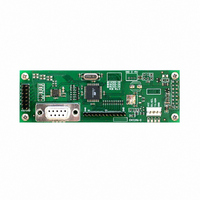VK202-25 Matrix Orbital, VK202-25 Datasheet - Page 18

VK202-25
Manufacturer Part Number
VK202-25
Description
VFD ALPHA/NUM DISPL 20X2 SER/I2C
Manufacturer
Matrix Orbital
Series
VK202-25r
Datasheet
1.VK202-25.pdf
(35 pages)
Specifications of VK202-25
Outline L X W X H
116.00mm x 37.00mm x 29.48mm
Viewing Area
89.75mm L x 11.50mm W
Display Format
20 x 2
Display Type
Character
Format
5 x 7 Dots
Character Size
4.70mm H x 2.40mm W
Interface
Serial
Operating Temperature
-20°C ~ 70°C
Product
Character Display Modules
Character Count X Line
20 x 2
Module Size (w X H X T)
116 mm x 37 mm x 29.48 mm
Operating Temperature Range
- 20 C to + 70 C
Dot Format
5 x 7
Viewing Area (w X H)
89.75 mm x 11.5 mm
Lead Free Status / RoHS Status
Lead free / RoHS Compliant
Voltage - Supply
-
Number Of Dots
-
Lead Free Status / Rohs Status
Details
Other names
635-1020
4.3 I
The keypad is read by I²C master read. In short, this means that a read of the module will always return the
first unread key press. A read is initiated by writing to the module with its base address plus 1, then
clocking the module’s return byte after the module releases the SDA line. Much more detail on this basic
I²C function can be found in the I²C specification by Philips. A good reference is also available at
The module contains a ten key press buffer so that it can be polled for key presses at an infrequent rate
(every 500 to 1000 mS is typical). All returned key presses indicate the presence or absence of additional
logged key presses by the most significant bit (MSB - bit 7). If the user has pressed two keys since the last
poll of the keypad interface, the first read will return the key code with bit 7 set and the second read will
return the key code with bit 7 clear. The application must take into account this bit to keep up with user key
presses. If there are no keypresses detected, the module will return zero (0x00).
4.4 RS-232 Interface
By default on any press of a key, the module will immediately send out the key code at the selected baud
rate. This behavior can be modified using commands found in the next section.
4.5 Keypad Commands
Before issuing commands to the VK202-25 please read sections 7.2 and 7.3.
4.5.1 Auto repeat mode on (254 126 [mode])
Two Modes of auto repeat are available and are set via the same command.
1.
2.
VK202-25 rev. 05
Resend Key Code: This mode is similar to the action of a keyboard on a PC. In this mode, when a key
is held down, the key code is transmitted immediately followed by a 1/2 second delay. After this delay,
key codes will be sent via the RS - 232 interface at a rate of about 5 codes per second. This mode has
no effect if polling or if using the I²C interface.
Key down / Key up codes: This mode may be used when the typematic parameters of the Resend Key
code mode are unacceptable or if the unit is being operated in polled mode. The host system detects the
press of a key and simulates an auto repeat inside the host system until the key release is detected.
In this mode, when a key is held down, the key code is transmitted immediately and no other codes will
be sent until the key is released. On the release of the key, the key release code transmitted will be a
value equal to the key down code plus 20 hex. For example, the key code associated with key 'P' (0x50)
is pressed, the release code is 'p' (0x70).
In RS-232 polled mode (see 4.5.4 below) or via the I²C interface, the key down / key up codes are
used; however, the user should be careful of timing details. If the poll rate is slower than the simulated
auto – repeat it is possible that polling for a key up code will be delayed long enough for an unwanted
key repeat to be generated (see Figure 4-2).
2
C Interface
http://www.ping.be/~ping0751/i2cfaq/i2cindex.htm
[mode] = 0x00 gives Resend Key Code mode
[mode] = 0x01 gives Key down / Key up code mode
18
















